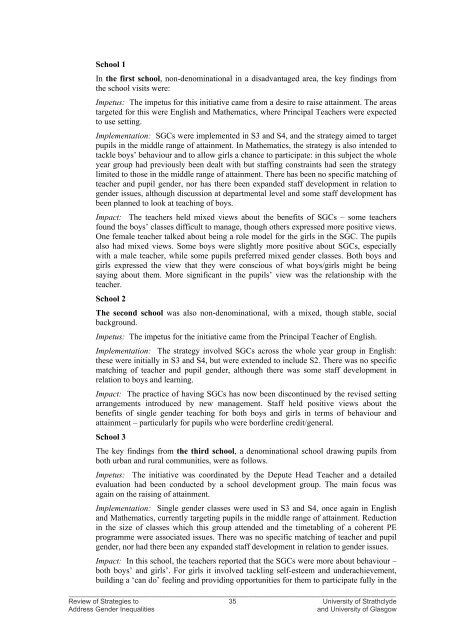Review of Strategies to Address Gender Inequalities in Scottish ...
Review of Strategies to Address Gender Inequalities in Scottish ...
Review of Strategies to Address Gender Inequalities in Scottish ...
You also want an ePaper? Increase the reach of your titles
YUMPU automatically turns print PDFs into web optimized ePapers that Google loves.
School 1In the first school, non-denom<strong>in</strong>ational <strong>in</strong> a disadvantaged area, the key f<strong>in</strong>d<strong>in</strong>gs fromthe school visits were:Impetus: The impetus for this <strong>in</strong>itiative came from a desire <strong>to</strong> raise atta<strong>in</strong>ment. The areastargeted for this were English and Mathematics, where Pr<strong>in</strong>cipal Teachers were expected<strong>to</strong> use sett<strong>in</strong>g.Implementation: SGCs were implemented <strong>in</strong> S3 and S4, and the strategy aimed <strong>to</strong> targetpupils <strong>in</strong> the middle range <strong>of</strong> atta<strong>in</strong>ment. In Mathematics, the strategy is also <strong>in</strong>tended <strong>to</strong>tackle boys’ behaviour and <strong>to</strong> allow girls a chance <strong>to</strong> participate: <strong>in</strong> this subject the wholeyear group had previously been dealt with but staff<strong>in</strong>g constra<strong>in</strong>ts had seen the strategylimited <strong>to</strong> those <strong>in</strong> the middle range <strong>of</strong> atta<strong>in</strong>ment. There has been no specific match<strong>in</strong>g <strong>of</strong>teacher and pupil gender, nor has there been expanded staff development <strong>in</strong> relation <strong>to</strong>gender issues, although discussion at departmental level and some staff development hasbeen planned <strong>to</strong> look at teach<strong>in</strong>g <strong>of</strong> boys.Impact: The teachers held mixed views about the benefits <strong>of</strong> SGCs – some teachersfound the boys’ classes difficult <strong>to</strong> manage, though others expressed more positive views.One female teacher talked about be<strong>in</strong>g a role model for the girls <strong>in</strong> the SGC. The pupilsalso had mixed views. Some boys were slightly more positive about SGCs, especiallywith a male teacher, while some pupils preferred mixed gender classes. Both boys andgirls expressed the view that they were conscious <strong>of</strong> what boys/girls might be be<strong>in</strong>gsay<strong>in</strong>g about them. More significant <strong>in</strong> the pupils’ view was the relationship with theteacher.School 2The second school was also non-denom<strong>in</strong>ational, with a mixed, though stable, socialbackground.Impetus: The impetus for the <strong>in</strong>itiative came from the Pr<strong>in</strong>cipal Teacher <strong>of</strong> English.Implementation: The strategy <strong>in</strong>volved SGCs across the whole year group <strong>in</strong> English:these were <strong>in</strong>itially <strong>in</strong> S3 and S4, but were extended <strong>to</strong> <strong>in</strong>clude S2. There was no specificmatch<strong>in</strong>g <strong>of</strong> teacher and pupil gender, although there was some staff development <strong>in</strong>relation <strong>to</strong> boys and learn<strong>in</strong>g.Impact: The practice <strong>of</strong> hav<strong>in</strong>g SGCs has now been discont<strong>in</strong>ued by the revised sett<strong>in</strong>garrangements <strong>in</strong>troduced by new management. Staff held positive views about thebenefits <strong>of</strong> s<strong>in</strong>gle gender teach<strong>in</strong>g for both boys and girls <strong>in</strong> terms <strong>of</strong> behaviour andatta<strong>in</strong>ment – particularly for pupils who were borderl<strong>in</strong>e credit/general.School 3The key f<strong>in</strong>d<strong>in</strong>gs from the third school, a denom<strong>in</strong>ational school draw<strong>in</strong>g pupils fromboth urban and rural communities, were as follows.Impetus: The <strong>in</strong>itiative was coord<strong>in</strong>ated by the Depute Head Teacher and a detailedevaluation had been conducted by a school development group. The ma<strong>in</strong> focus wasaga<strong>in</strong> on the rais<strong>in</strong>g <strong>of</strong> atta<strong>in</strong>ment.Implementation: S<strong>in</strong>gle gender classes were used <strong>in</strong> S3 and S4, once aga<strong>in</strong> <strong>in</strong> Englishand Mathematics, currently target<strong>in</strong>g pupils <strong>in</strong> the middle range <strong>of</strong> atta<strong>in</strong>ment. Reduction<strong>in</strong> the size <strong>of</strong> classes which this group attended and the timetabl<strong>in</strong>g <strong>of</strong> a coherent PEprogramme were associated issues. There was no specific match<strong>in</strong>g <strong>of</strong> teacher and pupilgender, nor had there been any expanded staff development <strong>in</strong> relation <strong>to</strong> gender issues.Impact: In this school, the teachers reported that the SGCs were more about behaviour –both boys’ and girls’. For girls it <strong>in</strong>volved tackl<strong>in</strong>g self-esteem and underachievement,build<strong>in</strong>g a ‘can do’ feel<strong>in</strong>g and provid<strong>in</strong>g opportunities for them <strong>to</strong> participate fully <strong>in</strong> the______________________________________________________________________________________<strong>Review</strong> <strong>of</strong> <strong>Strategies</strong> <strong>to</strong> 35 University <strong>of</strong> Strathclyde<strong>Address</strong> <strong>Gender</strong> <strong>Inequalities</strong>and University <strong>of</strong> Glasgow
















